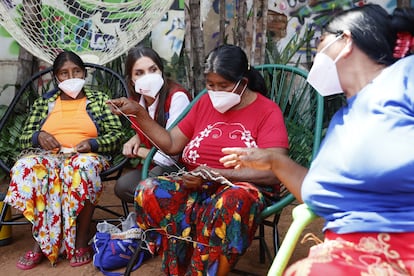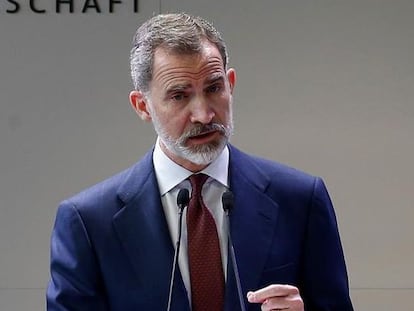Spain’s Queen Letizia carves out her own public role
The Spanish Constitution only says what the wife of the head of state cannot do. She has to make up her own agenda, where women’s issues and development aid figure prominently


In Spain, the Royal Household’s media services do not normally provide details about the outfits worn in public by Queen Letizia. They know that she does not like her choice of clothes to eclipse her work – and in any case, the brands she shops from already do a good job of sharing that information, ensuring that the outfits worn by the queen quickly sell out.
The only time that La Zarzuela palace, the seat of the Royal Household, changes this policy is when “the clothes become the message,” as with Doña Letizia’s trip to Paraguay this past week, when she was seen dressed as an aid worker throughout her stay in the South American nation.
The Spanish Constitution contains one single article describing the role of the queen consort, and then only to explain what she may not do: to take on constitutional duties, save exceptionally as a regent if King Felipe VI should die before the heir to the Spanish throne, Princess Leonor, reaches the age of majority.
As such, it is largely up to the wife of the reigning monarch to write her own job description. Doña Letizia inherited several honorary presidencies from her mother-in-law Queen Sofía when her husband ascended to the throne in 2014, including those of the Red Cross and Unicef. She also has a representative role at the United Nations’ Food and Agriculture Organization (FAO) and is involved with several non-profits in an unofficial capacity, including the Spanish Federation of Rare Diseases.
The queen’s agenda lists around 200 activities a year, most of them shared with the king. She has her own small secretarial service and receives additional support from the Royal Household’s protocol, security and media services. Doña Letizia enjoys an annual stipend of €163,000 assigned to her by Felipe VI from the royal family’s allocation in the national budget.
The queen’s aides say that she does not enjoy purely decorative positions, and it is evident that Doña Letizia’s character does not fit in well with ornamental roles. A former journalist, she still asks questions and makes comments every time she can. At age 49 and after seven years in the post, the queen has retained her passionate attitude while gaining self-confidence and restraint.
Although the word feminist does not normally show up on her agenda, most of the activities sponsored by Queen Letizia tend to have something in common: providing support for women to shield them from abuse, whether physical, psychological, sexual or workplace-related. Sources at La Zarzuela note that the queen has been involved in the fight against gender violence since 2017, when a national pact was signed by all the main political parties. The date is not irrelevant, as the queen cannot publicly support initiatives lacking political consensus in Spain. The issue has recently become problematic, however, because the ultranationalist party Vox has broken this consensus, just as it rejects the UN sustainable development goals that underpin Spain’s humanitarian aid policy.
Trip to Paraguay
International trips involving development aid are the most visible part of Doña Letizia’s annual agenda. On November 2, the queen boarded an A330 aircraft bound for Paraguay, and spent part of the 14-hour journey reading a report on human smuggling rings drafted by APRAM, a support group for women caught up in prostitution, ahead of conversations with local experts on the subject.
In the capital of Asunción, however, the issue of Doña Letizia’s clothing once again gained prominence after a Paraguayan opposition lawmaker, Celeste Amarilla of the Liberal Party, criticized the casual outfit worn by “the journalist-turned-queen” upon her arrival in Paraguay. According to Amarilla, “we deserved one of the dresses that you keep in your closet, not the kind of vest used by your guards and your secretary.” The Paraguayan company that made the vest used by Doña Letizia, Uniformes Fabricato, quickly came out in defense of its products.
In under 48 hours, the Spanish royal visited the Technical Cooperation Office, a center for women’s health, a workshop, Jesuit-run missions in Paraná, a cultural center and a family center, all of which are funded by Spain. One of the places she visited is Bañado Sur, one of Asunción’s poorest neighborhoods, where many of its 25,000 residents live off the giant neighboring dump. A local workshop run by nine women gave Doña Letizia and Paraguay’s First Lady Silvana Abdo two necklaces made with recycled tin, copper and wire from the dump. Later, the queen chatted with Jessica and Majali, two school dropouts who had signed up for a cooking workshop in a bid to find work in the tourism sector. “She is very down-to-earth,” said Jessica, 19, about Doña Letizia, who had a message for them before leaving for her next appointment: “Spanish development aid is going to continue here, it will not abandon you.”
Besides the social engagements, the queen’s trip helped release a $175 billion (€150 billion) credit line, of which $10 billion (€8.6 billion) will be provided by the European Union and the rest by the Inter-American Development Bank, to improve sanitation infrastructure in Lambaré, in the suburbs of Asunción.
For the entire duration of her stay in the South American country, and against all expectations, Doña Letizia continued to wear the aid worker vest that earned her criticism inside the Chamber of Deputies on the day of her arrival. Meanwhile, the small company that produces this item reported a huge spike in sales. According to its own advertising, the vest is “ideal for guards, secretaries and queens.”
Tu suscripción se está usando en otro dispositivo
¿Quieres añadir otro usuario a tu suscripción?
Si continúas leyendo en este dispositivo, no se podrá leer en el otro.
FlechaTu suscripción se está usando en otro dispositivo y solo puedes acceder a EL PAÍS desde un dispositivo a la vez.
Si quieres compartir tu cuenta, cambia tu suscripción a la modalidad Premium, así podrás añadir otro usuario. Cada uno accederá con su propia cuenta de email, lo que os permitirá personalizar vuestra experiencia en EL PAÍS.
¿Tienes una suscripción de empresa? Accede aquí para contratar más cuentas.
En el caso de no saber quién está usando tu cuenta, te recomendamos cambiar tu contraseña aquí.
Si decides continuar compartiendo tu cuenta, este mensaje se mostrará en tu dispositivo y en el de la otra persona que está usando tu cuenta de forma indefinida, afectando a tu experiencia de lectura. Puedes consultar aquí los términos y condiciones de la suscripción digital.
More information
Últimas noticias
Maduro pleads not guilty before the federal court in New York: ‘I am still the president of Venezuela’
A new test can detect Alzheimer’s from a finger prick
UN team enters Sudanese city of El Fasher after paramilitary massacre: ‘It’s like a ghost town’
A recipe for resistance: Indigenous peoples politicize their struggles from the kitchen
Most viewed
- Gilles Lipovetsky: ‘If you want to live better and fall in love, take Prozac, don’t look to philosophy’
- Alain Aspect, Nobel laureate in physics: ‘Einstein was so smart that he would have had to recognize quantum entanglement’
- Alvin Hellerstein, a 92-year-old judge appointed by Bill Clinton, to preside over Maduro’s trial in New York
- Why oil has been at the center of Venezuela-US conflicts for decades
- Maduro’s downfall puts China’s relationship with Venezuela to the test










































